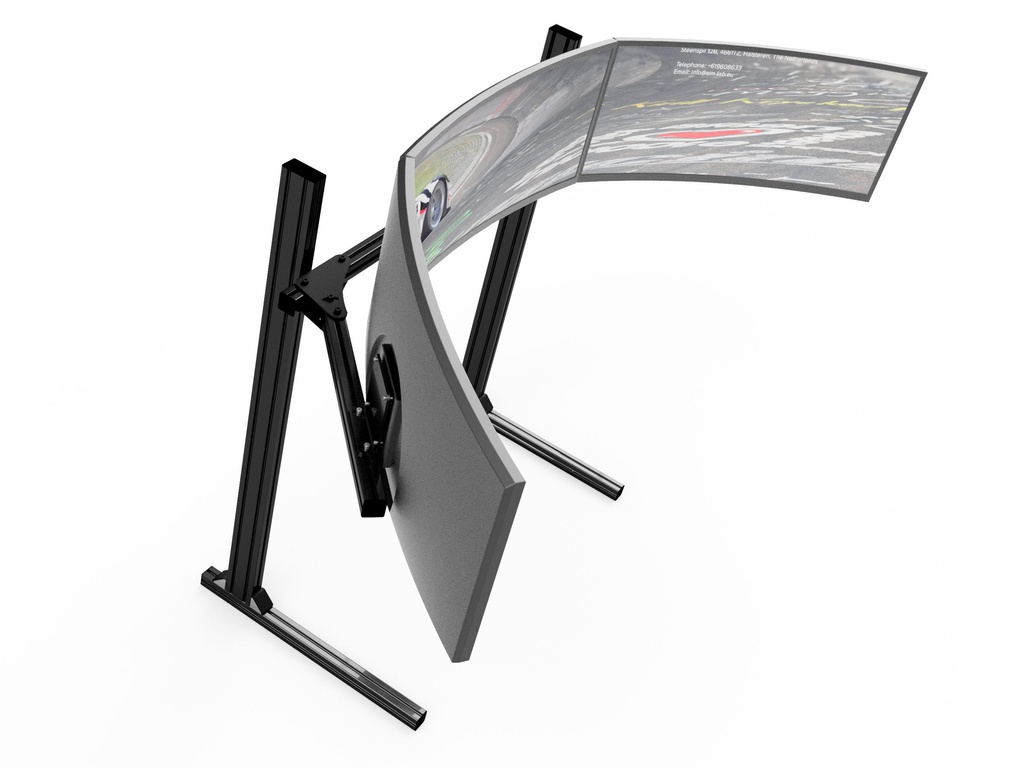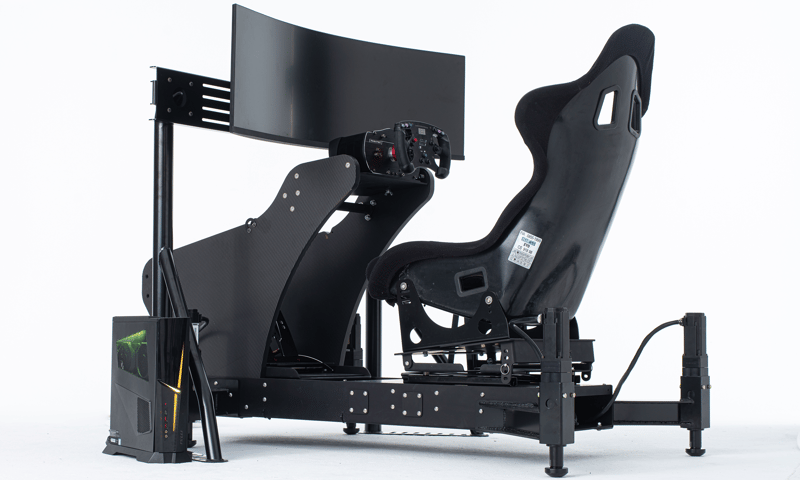1. Acknowledge the budget and space dedicated to your sim racing rig
The very first thing you need to decide upon when investing in your own rig is something that many people probably overlook: you need to know where you’re going to put it!
Whether you live in a studio apartment or a larger house, you can find a rig to fit your living quarters—but it’s better to make the decision before you buy.
If you have a partner or roommates living with you, it’s not a bad idea to have everyone in agreement on the location. Chances are your rig will be heavy and difficult to move once it’s all set up, so consider putting it in a location that everyone agrees it can stay long-term!
Also, if you have young children, it may be wise to keep your rig in a room that can be locked to prevent them from playing with it without your supervision—it is expensive, so it’s better to be safe than sorry!
If you want a rig that incorporates motion and haptic feedback, you should keep in mind that some motion rigs can be quite loud. This could play into where you want to put it, or if you want to incorporate motion at all.
Once you’ve firmly decided on a location, the next step is to take the exact measurements of the spot. Different parts and aspects of your rig will be available in different sizes and the easiest way to know if your desired pieces will fit is to know exactly how much space you’re working with! You also don’t want the rig to fit tightly like a puzzle piece, so make sure you account for some wiggle room around it.
Once you’ve decided on the space, the next step is arguably the biggest and most difficult decision of the entire process: deciding how much money you’re able to invest in it. Every step of the project will be dictated by the budget, so it’s important to be realistic yet controlled—if not, the cost can get way out of hand for your own personal finances. You can have a great rig with all the components you want without going crazy overboard on price, so make a budget and stick to it! Keep in mind that you can always upgrade in the future, so starting small isn’t a bad idea. The global sim racing community is quite large, so the second-hand market is easy to navigate!
2. Decide which sim racing features are most important to you
Once you’ve decided on your budget, the next step is to figure out which features of a sim racing rig you consider a need, a want, or a do-not-want.
For example, if you’re going to be using the rig to train for real life, then all the little details will be more important—the space between the pedals, the size of the steering wheel and the style of the seat can all be made to mirror the car you drive on a real track or stage! In this case, these details would be considered “needs.”
If you’re not investing in a sim racing rig to use as a training tool, then these features may just become “wants.” You don’t absolutely require the ones on your rig to mirror a your dream car but it would be fun if they did.
If you’re using the rig as a training tool, it’s best to allocate more of your budget to these types of details. If you’re using the rig purely for pleasure, then you don’t need to spend the extra money having these parts custom-made—you can simply decide what would work best for your budget and distribute the funds on other features that you want more and can make more of an impact on your performance.
Once you’ve made your lists of needs and wants, spend a good amount of time speaking to experts and researching the best parts for your size specs and your budget. Be sure to allocate the budget properly based on your list of needs and wants—If you “need” a specific, higher-grade chassis, shifter, wheel, pedals, wheelbase and more, it can get expensive quick!
If you’d like more information on what a professional-grade rig looks like, check out this video of NASCAR driver Anthony Alfredo breaking down what goes into his sim racing rig.

3. Consider your desired gaming method, upgrade path and make your first purchase!
After your budget, location and most important features are figured out, it’s time to decide on another aspect of your sim racing rig that will impact you every time you race: whether you want to race on a PC or on a console.
While both are good and both have their pros and cons, the decision really boils down to which games you see yourself playing long-term. When you know what games you want to play, look into their availability and popularity on PC vs on different consoles—this will help you choose the method that’s best suited for you!
Regardless of which one you end up going with, the decision will have a snowball effect on multiple decisions you have to make afterwards. For example, if you decide to build your rig around a PC, you’ll then have to determine what the best specs, ram and graphic cards are for your needs, followed by deciding if you want to build your own PC or buy a pre-existing model that has the requirements you desire. (Note: if you go with a PC, it’s better to start with high-quality parts—it will be difficult to sell used gaming PC components if you decide to upgrade at a later date).
That being said, while consoles are convenient and easy to use, there is more customizability and upgrade potential with PC’s. They also tend to attract a lot of bigger titles and are preferred by all kinds of sim racers for these reasons.
The next thing to consider is your future upgrade path. While it is possible to upgrade from console to PC (or vice versa) later on, you’ll want to purchase hardware and software that’s compatible with both systems to save money down the road. However, if you’re sure you won’t want to switch in the future, there is no need to buy the (potentially more expensive) equipment that’s compatible with both.
Once you’ve considered your gaming method and upgrade path, this is likely the moment where you’ll make your first purchase! Among the first things to be purchased are your wheel and pedal set, which like any other part of your rig, need to be properly researched based on your desires. There are classic and inexpensive belt drives and high-end direct drive wheels, just as there are cheap pedal options with springs to more advanced options that provide haptic resistance. Decide what works best for you and revel in the moment!
4. Invest in your only visual cue
While haptic feedback and higher-grade pedals can help take your skills to the next level, arguably one of the most basic components of your rig is what’s most important: the monitors.
Your rig’s monitors are your visual cue to every single thing going on in the race: the environment, your competitors, car details, etc. They’re also the only visual cue you have—making it extremely important to invest in high-quality ones!
Even though you can technically get by racing on a one-monitor setup, you will not be as immersed in the race and you’ll be less aware of your environment, causing you to fall behind and never achieve your true potential. This is why when looking at what monitors to purchase, you should be looking to buy multiple high-quality ones or a single widescreen.
By having 1 large or three monitors that are a good size, have great resolution and great colours, you’re sure to be tuned in to all the visual cues you need to analyze the race and come out on top.
5. Decide on motion—and if integrating, research the appropriate chassis & actuators
If you’ve made your list of “needs” for your rig and haptic feedback was on it, you’ll have to go a step further to ensure you purchase the appropriate chassis and actuators for the job! Not all haptic feedback is made equal, and the same goes for chassis and actuators.
To get yourself started, you can watch this video made by Sim Seats that explains what you need to look for when integrating haptic feedback on a sim racing rig.
In essence, if you’ve decided to add haptic feedback to your rig, you’re going to need a chassis on which the actuators can be in tight—this increases the motion and feedback felt. You’ll also want your chassis to be rigid in order to correctly transmit all the information the actuators are sending the driver!
If you’ve decided to integrate haptic feedback to help you train for a real race, then you also have to consider that it should be as realistic as possible. Currently, D-BOX’s haptic system is the only one that’s licensed by the FIA, meaning that it has gone through extensive testing by FIA engineers.
Adding haptic feedback to a sim racing rig is a huge step and can be just as confusing as building your own rig from the ground-up. If you’re overwhelmed by all the information online and want more information before making a decision, feel free to check out our previous blog about the three biggest myths about haptic technology in sim racing.
Get organized before you purchase
For a sim racer, there are few things more exciting than deciding to invest in your very own setup for the first time. You’re motivated, ready to take your skills to the next level and excited to be able to play at home! However, when you realize that you have no idea where to start, those feelings of excitement can quickly turn into anxiety.
Though it can be overwhelming at times, there’s no need to panic—simply start with these five steps and you’ll be well on your way to getting yourself on the track.



